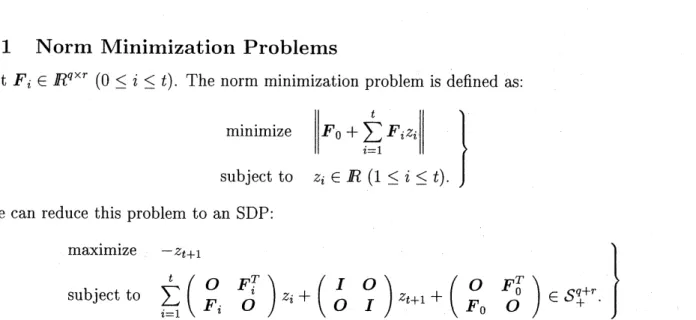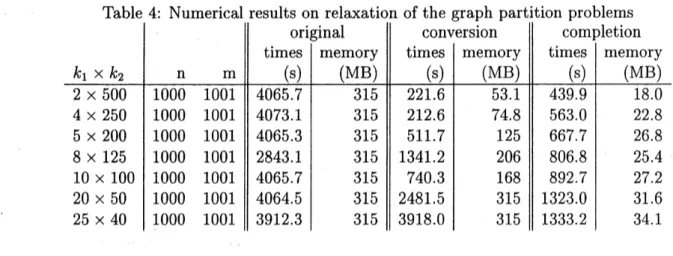Solving Sparse
Semidefinite
Programs
by
Matrix
Completion (part II)
東京大証
諭学系研究科
中田和秀(Kazuhide Nakata)
明都大学
工学研究科
藤沢克樹
(Katsuki Fujisawa)
東京工業大学
情報理工学研究田
福田 光浩(Mituhiro Fukuda)
東京工業大学
熊報理工学研究科
小島政和(Masakazu
Kojima)
京都大面
数理解析研究所
室田–
雄(Kazuo Murota)
This article succeds the previous article (Solving Sparse Semidefinite Programs by Matrix
Com-pletion (part I). In this article,
we
will proposea
prima]-dual interior-point method based on thesparse factorizationformula which arises from positive definite matrix completion [3]. We call this
method the completion method. Next we will present some numerical results which compare with
the original method, the conversion method and the completion method.
1
Completion Method
One disadvantage of the conversion method in the previous article is
an
increase in the numberof equality constraints. In this section, we propose a primal-dual interior-point method based
on
positive semidefinite matrix completion which we
can
apply directly to the original SDP withoutadding any equality constraints.
1.1
Search Direction
Various search directions [1, 4, 5, 6, 7, 8, 9, 10] have been proposed
so
far for primal-dualinterior-pointmethods. Amongothers, werestrict ourselves to the$\mathrm{H}\mathrm{R}\mathrm{V}\mathrm{W}/\mathrm{K}\mathrm{S}\mathrm{H}/\mathrm{M}$search direction [4, 6, 7].
Let $(\overline{X},\overline{\mathrm{Y}},\overline{z})$ be a point obtained at the $k\mathrm{t}\mathrm{h}$ iteration ofa primal-dual
interior-point method
using the $\mathrm{H}\mathrm{R}\mathrm{V}\mathrm{W}/\mathrm{K}\mathrm{S}\mathrm{H}/\mathrm{M}$ search direction $(k\geq 1)$
or
given initially $(k=0)$.
Weassume
that$\overline{X}\in S_{++}^{n}(F$,?$)$ and $\overline{\mathrm{Y}}\in S_{++}^{n}(E, 0)$.
In order to compute the $\mathrm{H}\mathrm{R}\mathrm{V}\mathrm{W}/\mathrm{K}\mathrm{S}\mathrm{H}/\mathrm{M}$ search direction, we use the whole matrix values for
both $\overline{X}\in S_{++}^{n}(F$, ?$)$ and $\overline{\mathrm{Y}}\in S_{++}^{n}(E, 0)$, so that we need to make a positive definite matrix
completion of$\overline{X}\in S_{++}^{n}$$(F$, ?$)$. Let $\hat{X}\in s_{++^{\mathrm{b}\mathrm{e}}}^{n}$the maximum-determir\’iantpositive definite matrix
completion of$\overline{X}\in S_{++}^{n}$$(F$,?$)$. Then wecompute the $\mathrm{H}\mathrm{R}\mathrm{V}\mathrm{W}/\mathrm{K}\mathrm{S}\mathrm{H}/\mathrm{M}$search direction (ffl, ff,$d_{Z)}$
by solving the system of linear equations
$A_{p}$ $\bullet$$dK=g_{p}(p=1,2, \ldots, m),$ $M\in S^{n}$
$\sum_{p=1}^{m}$
A&+ppff=H,
$M\in s^{n}(E, 0),$ $d\mathrm{z}\in R^{m},$$\}$ (1)
where $g_{p}=b_{p}-A_{p}$ $\bullet$$\hat{X}\in R(p=1,2, \ldots, m)$ (the primal residual), $H=A_{0}- \sum_{p}mA\overline{Z}=1p\mathrm{P}^{-\overline{\mathrm{Y}}}\in$ $S^{n}(E, 0)$ (the dual residual), $K=\mu I-\hat{X}\overline{\mathrm{Y}}$ (an $n\cross n$ constant matrix), and $\overline{d\mathrm{X}}$
denotes an $n\mathrm{x}n$
auxiliary matrix variable. The search direction parameter $\mu$ is usually chosen to be $\beta\hat{X}$ $\bullet$ $\overline{\mathrm{Y}}/n$ for
some
$\beta\in[0,1]$.
Wecan
reduce the system of linear equations (1) to .$Bdz=s,$ $ff=H- \sum_{p=1}A_{pp}dZm$,
$\overline{d\mathrm{X}}=(K-\hat{x}ff)\overline{\mathrm{Y}}-1,$ $dK=(\overline{dK}+f\overline{fl}^{T})/2,-$
(2)
where
$B_{pqpq}=\mathrm{T}\mathrm{r}\mathrm{a}\mathrm{C}\mathrm{e}A\hat{x}A\overline{\mathrm{Y}}^{-1}(p=1,2, \ldots, m, q=1,2, \ldots, m),$ $\}$
$s_{\mathrm{p}}=g_{p}$–Trace $A_{p}(K-\hat{x}H)\overline{\mathrm{Y}}^{-}1(p=1,2, \ldots, m)$
.
Note that $B$ is
a
positive definite symmetric matrix.As
we
haveseen
in the previous article, The maximum-determinant positive definite matrixcompletion $\hat{X}$
of $\overline{X}\in S_{++}^{n}(F$, ?$)$
can
be expressed in terms of the sparse factorization formula$\hat{x}=W^{-\tau_{W}-}1$, (3)
where $W$ is a lower triangular matrix which enjoys the same sparsity structure as $\overline{X}$
.
Also $\overline{\mathrm{Y}}\in$$S_{++}^{n}(E, 0)$ is factorized
as
$\overline{\mathrm{Y}}=NN^{T}$ without any fill-in’s except for entries in $F\backslash E$, where$N$ is
a
lower triangular matrix. Wecan
effectively utilize these factorizations of $\hat{X}$ and $\overline{\mathrm{Y}}$for
the computation of the search direction ($d\mathrm{x},$ff,$d_{Z)}$. In particular, the coefficients $B_{pq}(p=$
$1,2,$$\ldots,$$m,$ $q=1,2,$$\ldots,$$m)$ in the system (2) of linear equations is computed by
$B_{ij}$ $=$ $\sum_{k=1}^{n}(W-\tau W-1ek)TA(jN^{-T}N-1[A_{i}]_{*k}.)$ $(i,j=1,2, \cdots, m)$,
si $=$ $b_{i}+ \sum_{k=1}^{n}(W^{-^{\tau}}W-1e_{k})^{\tau_{H}}(N-TN-1[A_{i}]_{*k})$
.
$-\mu e_{k}^{\tau}N-^{\tau}N-1[A_{i}]*k$ $(i=1,2, \cdots, m)$
Here $[A_{i}]_{*k}$ denote the $k\mathrm{t}\mathrm{h}$ column of the matrix $A_{i}$
.
Since we just store the sparse and lowertriangular matrix $W$ and $N$ instead of $\overline{X}$
and $\mathrm{Y}$, we can not
use
the current computationalformulas. Instead, wecompute $B,\overline{d\mathrm{X}}$ and $s$ based
on
matrix-vector multiplications. For instance,to determine the the product $h=W^{-1}v$, we solve the linear system $Wh=v$, where $W$ is lower
triangular and sparse.
1.2
Step
Size
As we will see below inthe computation ofthe step length and the next iterate, we needthe partial
symmetric matrix with entries $[d\mathrm{X}]_{ij}$ specified in $F$, but not the whole search direction matrix
$dX\in S^{n}$ in the primalspace (hence the partialsymmetric matrix with entries $[\overline{d\mathrm{K}}]_{ij}$ specified in $F$
but not the whole matrix $\overline{dK}$
). Hence it is possible to carry out all the matrix computation above
using only partial matrices with entries specified in $F$
.
Therefore we can expect to save both CPUtime and memory in
our
computation of the search direction. To clarify the distinction betweenwith entries specified in $F$ in the discussions below,
we
use
the notation $d\hat{K}$ for the former wholematrix in $S^{n}$ and $d\overline{\mathrm{K}}$ for the latterpartial symmetric matrix in
$S^{n}(F$;?$)$
.
Now, supposing thatwe
have computed the $\mathrm{H}\mathrm{R}\mathrm{V}\mathrm{W}/\mathrm{K}\mathrm{S}\mathrm{H}/\mathrm{M}$ search direction ($d\overline{K},$$(Y, dZ)\in S^{n}\cross S^{n}(E, 0)\cross R^{m}$, and we
describehowtocompute
a
steplength $\alpha>0$and the nextiterate (X’,$\mathrm{Y}’,$$z’$) $\in S^{n}\cross S^{n}(E, 0)\cross R^{m}$.
Usually
we
compute the maximum $\hat{\alpha}$ of$\alpha’ \mathrm{s}\mathrm{s}\mathrm{a}\mathrm{t}\mathrm{i}\mathrm{s}\mathfrak{h}^{\gamma}$ing
$\hat{X}+\alpha d\hat{\mathrm{X}}\in S_{+}^{n}$ and $\overline{\mathrm{Y}}+\alpha ff\in S_{+}^{n}$, (4)
and let (X’,$\mathrm{Y}’,$ $Z’$) $=(\hat{X},\overline{\mathrm{Y}},\overline{z})+\gamma\hat{\alpha}(d\hat{K}, x, dz)$ for some $\gamma\in(0,1)$. Then $X’\in S_{++}^{n}$ and
$\mathrm{Y}’\in S_{++}^{n}(E, 0)$. The computation of$\hat{\alpha}$ is necessary to know how longwe can take the step length
along the search direction $(f\hat{fl}, ff, dz)$. The computation of$\hat{\alpha}$is usually carried out by calculating
the minimum eigenvalues of the matrices
$\hat{M}^{-1}d\hat{K}\hat{M}^{-\tau}$
and $N^{-1}KN^{-T}$,
where $\hat{X}=\hat{M}\hat{M}^{T}$
and $\overline{\mathrm{Y}}=NN^{T}$ denote the factorizations of$\hat{X}$
and $\overline{\mathrm{Y}}$, respectively.
Instead of (4),
we
proposeto employ$\overline{x}_{c_{\tau}c,}+\alpha d\overline{K}_{C_{\mathrm{r}}}c,$ $\in S_{+}^{C_{f}}(r=1,2, \ldots, \ell)$ and $\overline{\mathrm{Y}}+\alpha M\in S_{+}^{n}(E, 0)$
.
(5)Recall that $\{C_{r}\subseteq V : r=1,2, \ldots, \ell\}$ denotes the family of maximal cliques of$G(V, F^{\mathrm{O}})$ and $\ell\leq n$
.
Let $\overline{\alpha}$ be the maximum of$\alpha’ \mathrm{s}$ satisfying (5), and let
$(X’, \mathrm{Y}^{J}, z’)=(\overline{X},\overline{\mathrm{Y}},\overline{z})+\gamma(\overline{f}(d\overline{\kappa}, M, dz)\in S^{n}(F$, ?$)$ $\cross S_{++}^{n}(E, \mathrm{o})\cross R^{?n}$
for some $7\in(0,1)$
.
$X’\in S^{n}(F$,?$)$ has a positive definite matrix completion, so that the point $(X’, \mathrm{Y}’, z’)\in S_{++}^{n}(F$, ?$)$ $\cross S_{++}^{n}(E, \mathrm{o})\cross R^{m}$can
be the next iterate. In this case, the computationof$\overline{\alpha}$ is reduced to the computation of the minimum eigenvalues ofthe matrices
$\overline{M}_{r}^{-1}\overline{M}_{CrC}\mathrm{r}\overline{M}_{r}-\tau(r=1,2, \ldots, \ell)$ and $N^{-1}ffN^{-T}$,
where $\overline{X}_{C,C_{f}}=\overline{M}_{r}\overline{M}_{r}^{T}$ denotes
a
factorization of$\overline{X}_{C_{\mathrm{r}}C_{\Gamma}}(r=1,2, \ldots, \ell)$. Thus the computationofthe minimumeigenvalue of$\hat{M}^{-1}\hat{X}\hat{M}^{-^{\tau}}$
has been replaced by the computation ofthe minimum
eigenvalues of$\ell$ smaller submatrices $\overline{M}_{r}^{-1}d\overline{\kappa}_{c_{r}}c_{r},\overline{M}^{-^{\tau}}(r=1,2, \ldots, \ell)$. On the other hand, when
wecomputetheminimum eigenvalue of$N^{-1}KN^{-^{\tau}}$, we cancompute it easily byLanczos methods,
because $N$ and $K$
are
sparse and we can compute the multiplication between $N^{-1}cYN^{-}\tau$ andvector $v$ using technic
we
mentioned.2
Numerical
Experiments
All numerical experiments in thissectionwere executedon DEC AlphaStation (CPU Alpha
21164-$600\mathrm{M}\mathrm{H}\mathrm{z}$ with $1024\mathrm{M}\mathrm{B}$). For the original method, we used the SDPA $5.0[2]$. For the conversion
method,
we
first converted theSDPs
into block diagonal SDPs and solved them by the $\mathrm{S}\mathrm{D}\mathrm{P}\mathrm{A}[2]$.For the completion method, we used a new software called SDPA-C which we incorporated the
Let $F_{i}\in R^{q\cross r}(0\leq i\leq t)$. The
norm
minimization problem is definedas:
minimize $||F_{0}+ \sum_{i=1}^{t}Fiz_{i}||$
subject to $z_{i}\in R(1\leq i\leq t)$.
$\}$
We
can
reduce this problem toan
SDP:maximize $-z_{t+1}$
subject to $\sum_{i=1}^{t}z_{i}+z_{t+1}+\in S_{+}^{q+r}$.
$\}$
Table 1 shows the performance comparisons
among
the $\dot{\mathrm{o}}\mathrm{r}\mathrm{i}\mathrm{g}\mathrm{i}\mathrm{n}\mathrm{a}\mathrm{l}$method (SDPA), theconversion
method applied before solving with SDPA, and the completion method. As $q$ becomes larger, the
aggregate sparsity pattern and extended sparsity pattern becomes denser.
Table 1: Numerical results on norm minimization problems
In the
case
of norm minimization problems, the conversionniethod
is better than the othermethods.
2.2
Quadratic
Programs
with Box Constraints
Let $Q\in S^{n}$ and $q\in R^{n}$. The quadratic program with box constraints is defined as: $\mathrm{m}\mathrm{i}\mathrm{n}\mathrm{i}\mathrm{m}\mathrm{i}\cdot \mathrm{z}\mathrm{e}$
$\frac{1}{2}x^{T}Qx+q^{T}x$
We have the following semidefinite programming relaxation of the above problem
minimize $\frac{1}{2}$ $\bullet$ $X$
subject to
$\cdot X=1$
,$\bullet X=1(i=1,2, \cdots, n)$, $X\in S_{+}^{2+1}n$.
$\}$
Here $E_{ii}$ denotes the $n\cross n$ symmetric matrix with $(i, i)\mathrm{t}\mathrm{h}$ element 1 and all others $0$.
Table 2 shows the performance comparisons of these methods applied to this particular class
of problems. $\alpha$ denotes the sparsity of the objective function matrix. The entry “1001,1000” in
the$n$ column meansthat the primal matrix variable $X$ has block matrices of sizes $1001\cross 1001$ and
$1000\cross$1000.
Table 2: Numerical results
on
relaxation ofthe quadratic programs with box constraintsIn the
case
of SDP relaxations of quadratic programs with box constraints, the completionmethod is better than the other methods.
2.3
${\rm Max}$-cut
Problem.s
over
Lattice
Graphs
Let $G=(V, E)$ be a lattice graph which is of size $k1\cross k2$ with a vertex set $V=\{1,2, ..., n\}$,
and
an
edge set $E=\{(i,j) : i,j\in V, i<j\}$.
We assigna
weight $C_{ij}=C_{ji}$ to each edge$(i, j)\in E$
.
The maximum cut problem is to find a partition $(L, R)$ of $V$ that maximizes the cut$c(L, R)=\Sigma_{i\in L},\in R{}_{ji}Cj\cdot$
Introducing.
a variable vector $u\in R^{n}$, wecan
,
$\mathrm{r}\mathrm{e}\mathrm{f}\mathrm{o}\mathrm{r}\mathrm{m}\mathrm{u}\mathrm{l}\mathrm{a}\mathrm{t}\mathrm{e}$ the problem as
a
nonconvex
quadratic program:maximize $\frac{1}{2}\sum_{i<j}c_{ij}(1-u_{i}u_{j})$ subject to $u_{i}^{2}=1(1\leq i\leq n)$. $\}$
Here each feasible solution $u\in R^{n}$ of this problem corresponds to
a
cut $(L, R)$ with $L=\{i\in$$V$ : $u_{i}=-1$
}
and $R=\{i\in V : u_{i}=1\}$. Ifwe
define $C$ to be the $n\cross n$ symmetric matrix withby $A_{0}=\mathrm{d}\mathrm{i}\mathrm{a}\mathrm{g}(c_{e})-c$, where $e\in R^{n}$ denotesthevector of
ones
anddiag$(ce)$ the diagonal matrixof the vector $Ce\in R^{n}$, we can obtain the following semidefinite programming relaxation of the
maximum cut problem:
minimize $-A_{0}$$\bullet$$X$
subject to $E_{ii}$ $\bullet$ $X=1/4(1\leq i\leq n),$ $X\in S_{+}^{n}$
.
$\}$
Table 3 compares the three algorithms for this problem. As $k1$ becomes larger, the aggregate
sparsity patterns remain
sparse,
but the extended sparsity pattern becomes denser.Table 3: Numerical results on relaxation ofthe maximum cut problems
For the semidefinite programmingrelaxation ofmaximum cut problems
over
lattice graphs, theconversion and the completion methods
are
better.2.4
Semidefinite Programming Relaxation of Graph-partition
Problem
Let $G=(V, E)$ be
a
lattice graph which is of size $k1\cross k2$ witha
vertex set $V=\{1,2, \ldots, n\}$, andan
edge set $E=\{(i,j) : i,j\in V, i<j\}$.
We assigna
weight $C_{ij}=C_{ji}$ to each edge $(i,j)\in E$.We
assume
that $n$ is aneven
number. The graph partition problem is to find auniform partition$(L, R)$ of$V,$ $i.e.$, apartition $(L, R)$ of$V$ with the same cardinality $|L|=|R|=n/2$, that minimizes
the cut $c(L, R)=\Sigma_{i\in LjR}\in c_{ij}$. This problem is formulated
as a
nonconvex
quadraticprogram:
minimize $\frac{1}{2}\sum_{i<j}c_{ij}(1-uiu^{\backslash }j)$
subject to $(\Sigma_{i=1}^{n}u_{i})^{2}=0,$ $u_{i}^{2}=1(1\leq i\leq n)$.
As in themaximum cut problem,
we
can
derivea
semidefinite programming relaxation of thegraphpartition problem:
minimize $A_{0}$$\bullet$ $X$
subject to $E_{ii}$$\bullet$ $X=1/4(1\leq i\leq n),$ $E\cdot X=0,$ $X\in S_{+}^{n}$.
$\}$ (6)
Here $A_{0}$ and $E_{ii}(1\leq i\leq n)$
are
thesame
matrices as in the previous section, and $E$ denotes the $n\cross n$ matrix with all elements 1. Table 4 compares the three algorithms for this problem. As $k1$Table 4: Numerical results on relaxation of the graph partition problems
becomes larger, the aggregate sparsity patterns remain sparse, but the extended sparsity pattern
becomes denser.
For the semidefinite programming relaxation of graph partition problems
over
lattice graphs,the conversion and the completion methods
are
better.3
Concluding
Remarks
In this article,
we
explained the mechanisms of the completion method. Nextwe
presented somenumerical results which compared the original method, the conversion method and the completion
method. As a result, we confirmed the effectiveness of the conversion method and the completion
method.
References
[1] F. ALIZADEH, J.-P. A. HAEBERLY AND M. L. OVERTON, Primal-dual interior-point
meth-ods
f.or
semidefinite
programming: convergence rates, stability and numerical results, SIAM J.Optim., 8 (1998), pp.
746-768.
[2] K. FUJISAWA, M. KOJIMA AND K. NAKATA, SDPA (Semidefinite Programming Algorithm)
–User’s Manual –, Technical Report B-308, Department of Mathematical and
Comput-ing Sciences, Tokyo Institute of Technology, Japan, December 1995 (revised August 1996).
Available at $\mathrm{f}\mathrm{t}\mathrm{p}://\mathrm{f}\mathrm{t}\mathrm{p}.\mathrm{i}\mathrm{s}.\mathrm{t}\mathrm{i}\mathrm{t}\mathrm{e}\mathrm{c}\mathrm{h}.\mathrm{a}\mathrm{C}.\mathrm{j}\mathrm{p}/\mathrm{p}\mathrm{u}\mathrm{b}/\mathrm{O}\mathrm{p}\mathrm{R}\mathrm{e}\mathrm{s}/\mathrm{s}\mathrm{o}\mathrm{f}\mathrm{t}\mathrm{W}\mathrm{a}\mathrm{r}\mathrm{e}/\mathrm{S}\mathrm{D}\mathrm{P}\mathrm{A}$ .
[3] M. FUKUDA, M. KOJIMA, K. MUROTA AND K. NAKATA, Exploiting sparsity in
semidefinite
programming via matrix completion I.. general framework, SIAM J. Optim., to appear.
[4] C. HELMBERG, F. RENDL, R. J. VANDERBEI AND H. WOLKOWICZ, An interior-point
method
for
semidefinite
programming, SIAM J. Optim., 6 (1996), pp. 342-361.[5] M. Kojima, M. Shida and
S.
Shindoh, “Search directions in theSDP
and themonotoneSDLCP:
[6] M. Kojima, S. Shindoh and S. Hara, $‘(\mathrm{I}\mathrm{n}\mathrm{t}\mathrm{e}\mathrm{r}\mathrm{i}\mathrm{o}\mathrm{r}$-point methods for the monotone semidefinite
linear complementarity problems,”
SIAM
Journal on Optimization 7 (1997) 86-125.[7] R. D. C. MONTEIRO, Primal-dual path-following algorithms
for semidefinite
programming,SIAM
J. Optim., 7 (1997), pp.663-678.
[8] R.D.C. Monteiro and Y. Zhang, (‘A unified analysis for a class of path-following
primal-dual interior-point algorithms for semidefinite programming,” Mathematical Programming 81
(1998)
281-299.
[9] Yu. E. NESTEROV AND M. J. TODD, Primal-dual interior-point methods
for self-scaled
cones,SIAM J. Optim., 8 (1998), pp.
324-364.
[10] M.J. Todd, K.C. Toh and R.H. T\"ut\"unc\"u, $‘(\mathrm{O}\mathrm{n}$ the
Nesterov-Todd
direction in semidefiniteprogramming,” Technical Report, School of Operations Research and Industrial Engineering,
Cornell University, Ithaca, New York 14853-3801, USA, March 1996, Revised May 1996, to



